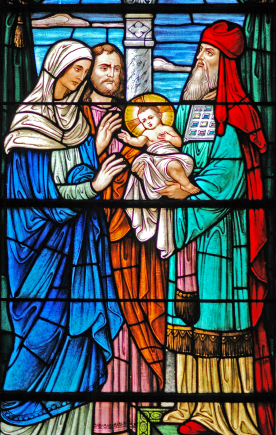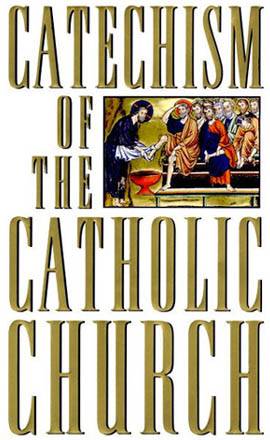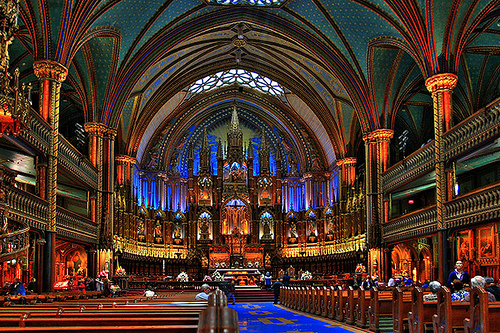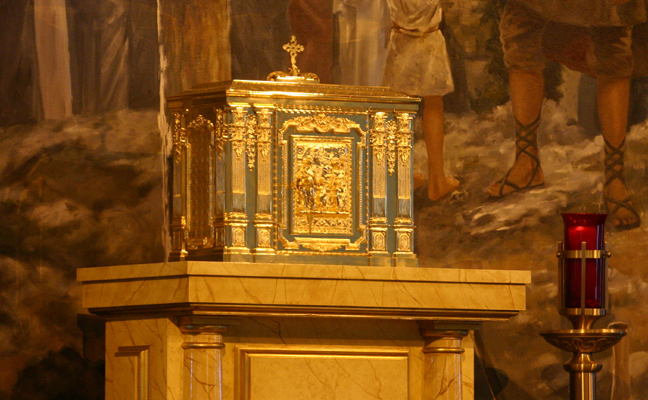Howdy everyone! This is a blog post about all those little symbolic (but often very confusing) things that Catholics do. Catholicism is a religion of ceremony, we like glorious and symbolic things surrounding us! So, let’s get started!
Why do Catholics…
… have stained glass windows?
As most of you know, the Catholic Church is the original Christian religion. We’ve been around for 2000 years! For most of this time, the majority of people on earth were illiterate. They could neither read nor write their own language, much less the Bible, which was written in Latin! So the Church decided to use pictures to teach bible stories, like the one above (the Presentation.) The people learned their faith, the artisans got paid, and churches looked awesome.
… say novenas? Isn’t repetitive prayer bad?
A novena is a series of prayers said over nine days (the root word, Novem, is latin for “nine,”) usually centered around a specific saint or feast day. There are hundreds of types of novenas for every petition under the sun! The first novena was when the apostles sat in the upper room after the Ascension of Christ for nine days waiting for the Holy Spirit on Pentecost. Since then, the idea of nine days of prayer has become very popular.
… Kneel and cross themselves when entering or exiting a pew?
The kneeling is a sign of respect. I mean, people, this is GOD we’re in front of. The center and axis and crux of every Christian’s life and the entire universe! The guy who became a human being, died a nasty death, and rose again so that WE could go to heaven! HE DESERVES RESPECT. The signing of the cross is a deeply symbolic action, taken from when Jesus said “take up your cross and follow me.” (Matt. 16:24) This is us symbolically taking up our cross, telling Jesus that not only would we take up an actual cross (as in martyrdom) but that we will take up all the little crosses, the little annoyances that plague us every day, for his sake.
… baptize infants? Aren’t they too young to understand what’s going on?
The church mandates that Catholics baptize infants because Jesus said in Matt. 19:24 “Let the children come to me, and do not hinder them, for to such belongs the kingdom of God!” Even if the child is too young to understand what’s going on, the sacrament a) takes away original sin, so that, in the case of sudden death, the child can go to heaven, and b) for the parents, releases an outpouring of graces and holds them to their promise to raise the child Catholic, hopefully cementing their own faith.
… have a Catechism? Isn’t the bible enough?
All the basics of Catholic teaching can be found in the Bible, but there are certain things that are not fully explained in the Good Book. Catholics have a Triumvirate from which comes all Catholic doctrine, made up of Scripture, Tradition, and the Magisterium. The Magisterium is made up of the pope and of the bishops in communion with him and with the teaching of the Church. The Catechism is like a list of all Catholic teaching, taken from scripture and sacred Tradition, and compiled by the Magisterium. It’s a pretty long book, but every question you have about Catholic teaching can be found inside. If you want to learn about the Catholic faith, get a good Catechism (the one above is a good choice! Or, if you have a question right now, here’s the official Catechism website at the Vatican! http://www.vatican.va/archive/ENG0015/_INDEX.HTM)
… call the bread at Mass the “Eucharist? What does that mean, and why can’t non-Catholics receive it?
The word Eucharist comes from the Greek “Eucharistia” meaning “to give thanks.” In the Catechism, section 1328, we read that:
“The inexhaustible richness of this sacrament is expressed in the different names we give it. Each name evokes certain aspects of it. It is called Eucharist, because it is an action of thanksgiving to God. The Greek words eucharistein141 and eulogein142 recall the Jewish blessings that proclaim – especially during a meal – God’s works: creation, redemption, and sanctification.”
Non-Catholics, and Catholics who are in a state of mortal sin, cannot receive the Eucharist. This is out of respect again to God. God should not have to dwell in a heart that has rejected him or who does not know him. To eat the Eucharist in a state of sin or as a non-Catholic is a grave sin, a sacrilege.
… have such big, grandiose churches? Isn’t that a little pretentious?
Let me introduce you to the Basilica of Notre Dame de Montreal.
We Catholics are suckers for beauty. We’re the people who invented the Gothic Style, who painted the Sistine Chapel, who patroned the greatest painters and sculptors on Earth, pioneers like like Michelangelo, Leonardo DaVinci, and Raphael. We believe that God is best glorified in the glorious, and that the houses of God should reflect the infinite beauty of God. God isn’t just all-powerful or all-knowing, but all-beautiful as well. A church should stand out from any other building you see.
… have a red candle near the Tabernacle?
The red candle is called the sanctuary lamp, and it’s one of the ceremonies that the Church took from the Jewish faith (the ner termid, or eternal flame.) It represents the eternal presence of God, and may only be extinguished when the Eucharist is not present in the Tabernacle (it is removed on Holy Thursday and replaced on Easter Vigil, to represent the loss of Christ and His subsequent Resurrection.)
… have celibate priests?
This is more of a practical law than a ceremonious one. There are two reasons for clerical celibacy: a) because a priest should concentrate on his flock, and a wife and kids would be distracting, and b) because the salary of a priest is low, and it’s hard to raise a family on it. Priests of the Eastern rites, however, are allowed to marry, but married priests cannot advance to the ranks of bishop and above.
… have statues of Mary and the saints in Church? Isn’t there a law about graven images? What about crucifixes?
Catholics have statues for much the same reason we have stained glass windows- to teach and remind people about great saints, who are role models for the Catholic person. These are not graven images, as we do not worship them in any way. It’s more like having a picture of a relative who has died or who lives far away, to remind you of them. We have crucifixes to remind us of the sacrifice of the Lord. Some of these can be quite gory- crucifixion was no joke. You were scourged with a roman flagellum, with lead or steel nails at the end, then forced to carry a heavy cross, then had a crown of sharp thorns pressed into your skull, then stripped naked, then had nails driven through some very sensitive nerves. You sat for hours, sometimes even days, in extreme agony, until your heart burst from the strain. Jesus didn’t just die a clean death for us- no, He died the most painful death ever invented by man. The crucifix forces us to think about that, think about how much Christ did for the love of us undeserving humans.
Now, before I go off on one of my tangents about how much God loves us (though, as anyone who has read this blog knows, it’s my absolute favorite subject) I’d better sign off. If you have any more questions about why Catholics do XYZ, please add a comment, and I’ll address them in my next post.
Love to all!
-Tani





